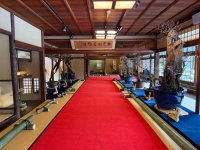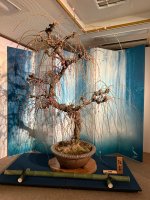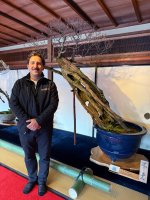Canada Bonsai
Chumono
- Messages
- 537
- Reaction score
- 1,690
The Nagahama Bonbai Exhibition takes place every year, in Nagahama, Japan.
It will be celebrating 75 years in 2026.
The collection is exclusively made up of Ume.
It is a great exhibition to visit during the break between the first and second week of Kokufu. Nagahama is only a short train ride away from Tokyo, and there are many other reasons to visit Nagahama (for me, those are Lake Biwa and its ingredients such as carp, biwa trout, moroko (fish), and duck, as well as the region's local dishes such as Funazushi and Yakisaba Somen
These ume range from 40 to 400 years old. Some are strong, while others appear structurally fragile

Some are former orchard trees, while others came from public and private landscapes, and many came from private collections. The ume are of course housed outdoors all year, at 4 different sites, and only brought indoors for the exhibition. Trees are moved daily, despite the fact that some of the heaviest trees weigh as much as 800kg (1700lbs). I had the rare privilege of visiting their outdoors sites.

Some of them have incredible degrees of ramification! It should be noted that this is not always possible nor is it always desired, both in the case of bonbai and bonsai.



The exhibition itself takes places in several zones. There are trees located outdoors, and others indoors spread across several rooms and floors of a magnificent building originally built for the purpose of a proving a resting place (for 1 hour!!) for Emperor Meiji while travelling from Kyoto to Tokyo.

In this area, a different theme is chosen every year. This year, the theme was water

Seirei is a mere 40 years old - something that can be achieved in a single lifetime

On the other hand Shoryubai is 250 years old

...and hanging on by a thread. Moving this trees requires up to 10 people working with extreme caution since the trunk can no longer support the weight of the tree

Furo is 400 years old, and the old tree in the collection. Don't ever let those rumours convince you that 'Ume don't live long'. This tree is over 2m (6.5') tall from the ground.




This one has become so thin, it looks like scarf or ribbon


It will be celebrating 75 years in 2026.
The collection is exclusively made up of Ume.
It is a great exhibition to visit during the break between the first and second week of Kokufu. Nagahama is only a short train ride away from Tokyo, and there are many other reasons to visit Nagahama (for me, those are Lake Biwa and its ingredients such as carp, biwa trout, moroko (fish), and duck, as well as the region's local dishes such as Funazushi and Yakisaba Somen
These ume range from 40 to 400 years old. Some are strong, while others appear structurally fragile

Some are former orchard trees, while others came from public and private landscapes, and many came from private collections. The ume are of course housed outdoors all year, at 4 different sites, and only brought indoors for the exhibition. Trees are moved daily, despite the fact that some of the heaviest trees weigh as much as 800kg (1700lbs). I had the rare privilege of visiting their outdoors sites.

Some of them have incredible degrees of ramification! It should be noted that this is not always possible nor is it always desired, both in the case of bonbai and bonsai.



The exhibition itself takes places in several zones. There are trees located outdoors, and others indoors spread across several rooms and floors of a magnificent building originally built for the purpose of a proving a resting place (for 1 hour!!) for Emperor Meiji while travelling from Kyoto to Tokyo.

In this area, a different theme is chosen every year. This year, the theme was water

Seirei is a mere 40 years old - something that can be achieved in a single lifetime

On the other hand Shoryubai is 250 years old

...and hanging on by a thread. Moving this trees requires up to 10 people working with extreme caution since the trunk can no longer support the weight of the tree

Furo is 400 years old, and the old tree in the collection. Don't ever let those rumours convince you that 'Ume don't live long'. This tree is over 2m (6.5') tall from the ground.




This one has become so thin, it looks like scarf or ribbon


Last edited:





















